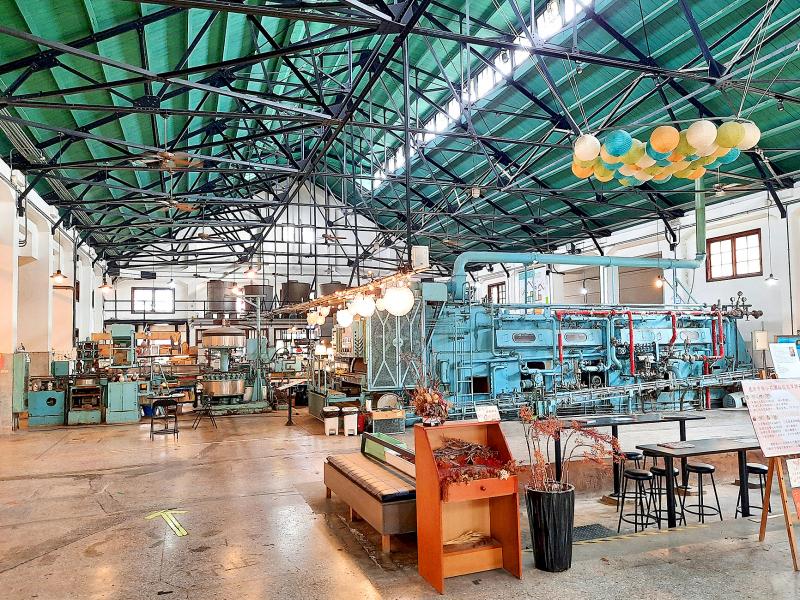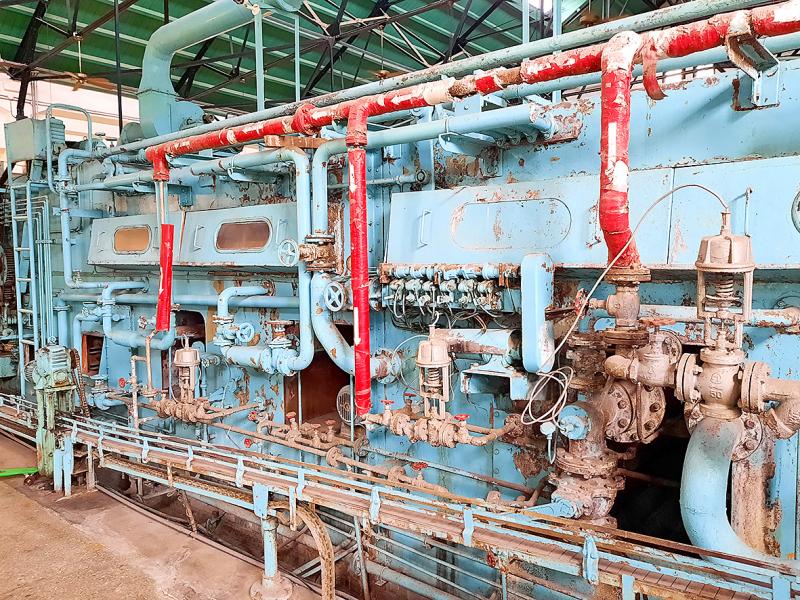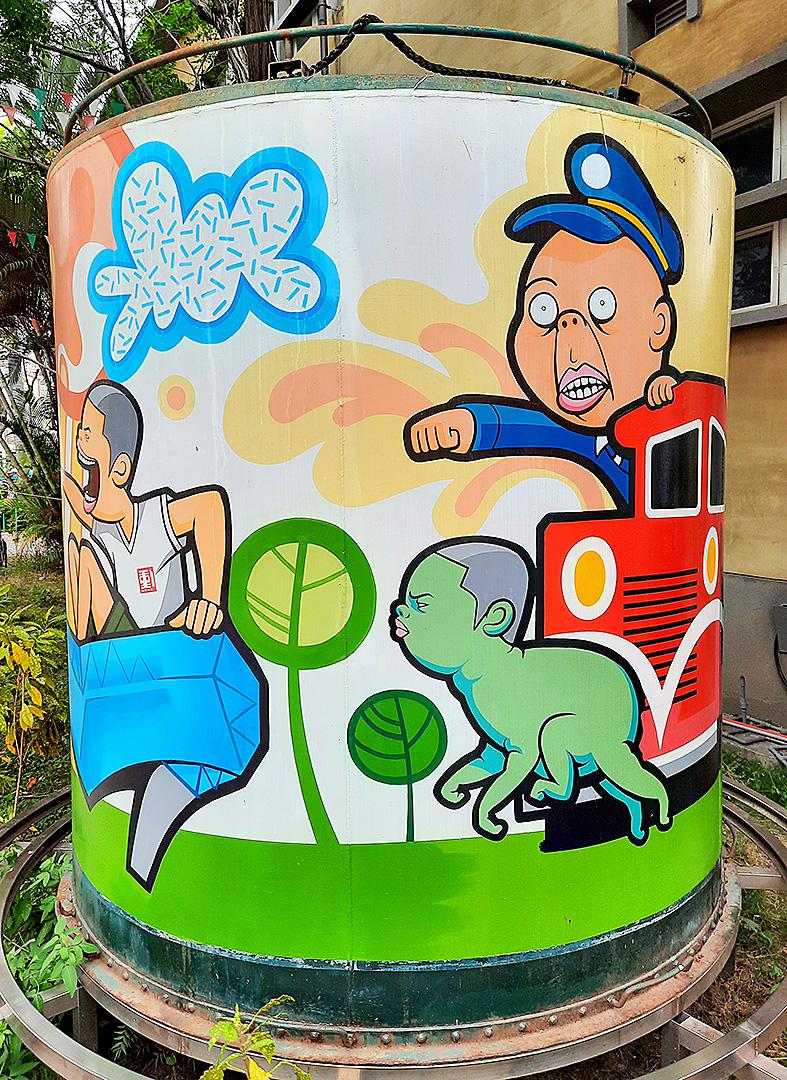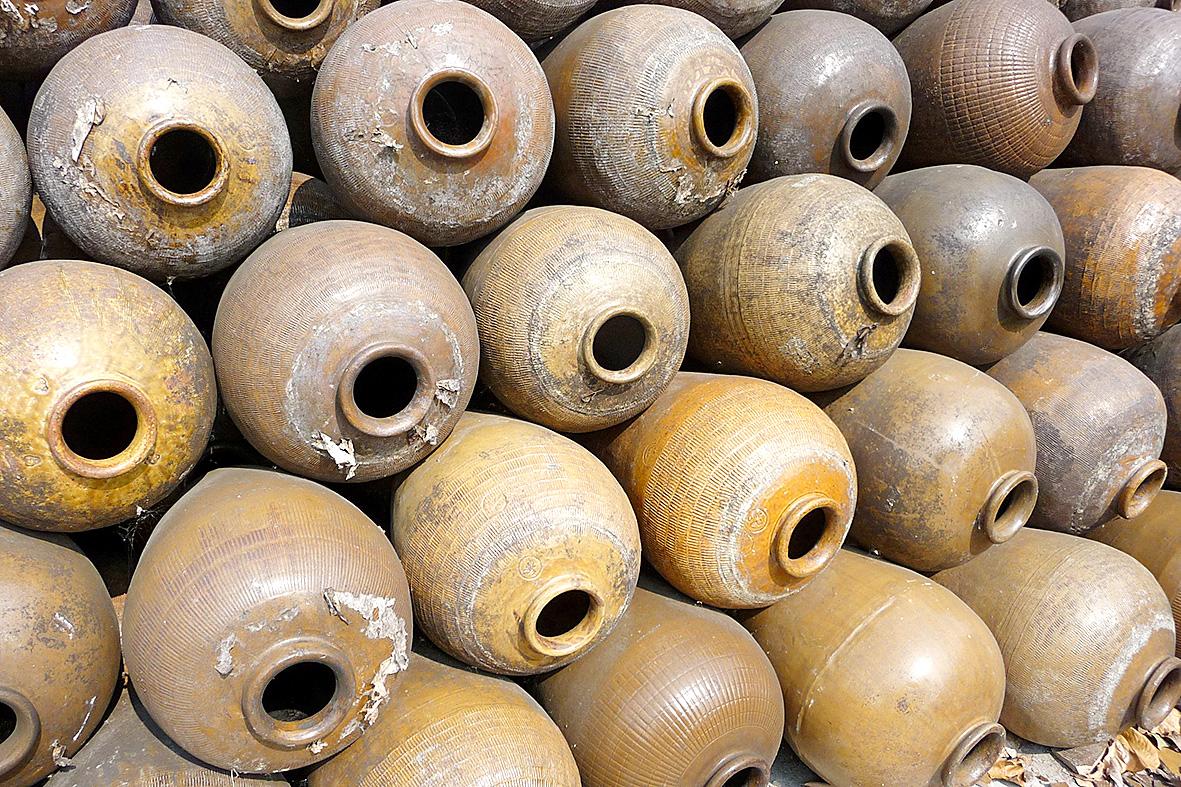By global standards, the Taiwanese aren’t great boozehounds. Annual per adult beer consumption is just a quarter of that in the US, and spirits aren’t drunk in anything like the quantity they’re enjoyed in other parts of Asia.
There’s a scientific explanation for this lack of interest in drink. Many Taiwanese (47 percent of the population, according to a Stanford University researcher) lack the gene required to properly metabolize alcohol.
Yet, as a result of Japanese rule, former alcohol-production sites occupy prominent locations in some of Taiwan’s cities. The colonizers not only monopolized alcohol production to help finance their governing of the island, but also imported a culture of drinking.

Photo: Steven Crook
The best known of these places is Huashan 1914 Creative Park (華山1914文創產業園區), a repurposed winery in central Taipei where production was halted in 1987.
Ostensibly, this was done so those living nearby would no longer have to put up with unpleasant smells. In reality, the authorities (which owned the site through the Taiwan Province Tobacco and Wine Monopoly Bureau, now Taiwan Tobacco & Liquor Corp, usually shortened to TTL) were itching to redevelop this prime piece of real estate. They were thwarted by activists, and an arts venue was born.
The 3.3-hectare Hualien Cultural and Creative Industries Park (花蓮文化創意產業園區), also known as Hualien A-Zone, preserves several warehouses and wooden buildings that once formed part of a government-run distillery.

Photo: Steven Crook
In the Jan. 25, 2019 Taipei Times (“Tramping around central Taichung”), I wrote about an old sake brewery a short walk from the back of Taichung TRA Station that’s now the Cultural Heritage Park (文化資產園區).
G9 CREATIVE PARK
Chiayi City now has a similar landmark. Chiayi Cultural and Creative Industries Park (嘉義文創園區), also known as G9 Creative Park, occupies a complex that was founded in 1916 by Taisho Brewing Co, Ltd.

Photo: Steven Crook
The distillery was transferred from the private sector to the public sector in 1922, when Taiwan’s alcohol industry became a state-run monopoly. Brewing or distilling for private consumption was outlawed, but I think it’s safe to assume that some people defied this prohibition.
Alcohol aficionados will be interested to know that, after World War II — by which time the site was managed by Taiwan Province Tobacco and Wine Monopoly Bureau — it became the first producer in the country of sorghum liquor. That clear spirit is now known in English by its Chinese name, kaoliang (高粱酒). Only later, in the early 1950s, did a team of distillers from Kinmen County pick up techniques from experts in Chiayi, and begin making their own kaoliang.
The complex suffered some damage in air raids in the final months of World War II. Repairs were made, and the site was expanded to just under four hectares.

Photo: Steven Crook
In the early 1970s, when the winery’s production lines were gradually relocated to a larger site north of the city in Minxiong Township (民雄), locals began to refer to the downtown complex as Chiayi Old Distillery (嘉義舊酒廠).
The oldest extant building on the site dates from 1924. The smokestack was 53m high until the 921 Earthquake in 1999; the height of the stump is 18m.
To the delight of those fascinated by industrial heritage, much of the distillery’s classic machinery has been left in situ.

Photo: Steven Crook
Inside the 84-year-old Building B — one of the larger structures within the complex — bottling and packaging equipment purchased from Japan in the late 1960s occupies much of the space. Between the machines, there are artists’ stalls.
Building C features an installation art project by Chiayi-born, Taipei-based Wang Su-fong (王素峰) called “Pink Go Home.” Comprising plastic tubes draped around a house-sized water boiler, its meaning wasn’t obvious to me.
A more enthralling sight lies inside Building N, where a small Chinese-only sign outside reveals the building’s original purpose. It used to be a wheat silo.
A walkway has been installed so visitors can look down into the two inverted cones where grain was stored, and there’s something deeply engrossing about the twelve pipes that almost converge at the bottom of each.
Chiayi Cultural and Creative Industries Park is open from 10am to 6pm, Tuesday to Sunday. For further information (in Chinese only), visit: www.g9park.com.
DIRECTIONS
If you arrive in Chiayi by train, turn right as soon as you exit the front of the TRA station and walk south. The old winery is less than 400m from the station, between Jhongshan Road and the railway tracks. If you cross the road, you’ll see Chiayi Art Museum (嘉義市立美術館). For opening hours and exhibition information, visit: chiayiartmuseum.chiayi.gov.tw.
PINGTUNG DISTILLERY
When TTL opened Pingtung Distillery (屏東酒廠) to the public, they probably expected people would stay close to the on-site shop and the tobacco exhibition hall. However, no one stopped me from cycling around every part of this 20-hectare industrial complex in a sleepy part of Neipu Township (內埔).
The shop stocks TTL products I’ve never seen elsewhere, such as lychee and black-plum wines, but there’s no price advantage compared to buying from a supermarket. The tobacco exhibition hall looks like it’s been shuttered for several years, presumably in keeping with the government’s anti-smoking stance.
Sharp odors waft through the grounds of the distillery. It’s described in some TTL publications as “the hometown of rice wine” (米酒的故鄉), but its output includes more than half a dozen different spirits.
One is Hua Tiau Chiew (花雕酒), a 16-percent ABV urn-matured beverage made from glutinous rice. In several locations around the complex, I saw photogenic stacks of ceramic urns.
Until earlier this year, the distillery also turned out Red-Label Rice Wine (紅標米酒), a once-popular cooking wine. Since early last year, part of the complex’s capacity has been devoted to meeting pandemic-era demand for rubbing alcohol.
Beer is not brewed here, but I’ve never seen so many beer bottles. Emptied Taiwan Beer bottles pass through the complex by the thousand. Those that arrive intact are kept in yellow crates. Those which haven’t survived are dumped in a corner.
Pingtung Distillery has been in Neipu since 1976, yet it was founded in Pingtung City half a century earlier.
At its old location, the distillery produced a cheap spirit with a high ethanol content known in Chinese as taibaijiu (太白酒). Made from a mix of rice and sweet potatoes, it was wholesaled to grocery stores in large jars which then retailed it by the glass.
As recently as the 1970s, many of those laboring on Pingtung’s sugar plantations carried their own cups, so they could enjoy a shot of taibaijiu before the walk or bike ride home.
Pingtung Distillery, at 34 Jianguo Road (建國路), is open from 9am to 5pm daily.
DIRECTIONS
The nearest bus stop is Yingcu (營區), served by four #8230 services per day from Pingtung City. More than a dozen bus routes serve Linluo Sport Park (麟洛運動公園), but you’ll need to walk almost 2km. If you drive, it goes without saying: Don’t drink.
Steven Crook has been writing about travel, culture and business in Taiwan since 1996. He is the author of Taiwan: The Bradt Travel Guide and co-author of A Culinary History of Taipei: Beyond Pork and Ponlai.

This is the year that the demographic crisis will begin to impact people’s lives. This will create pressures on treatment and hiring of foreigners. Regardless of whatever technological breakthroughs happen, the real value will come from digesting and productively applying existing technologies in new and creative ways. INTRODUCING BASIC SERVICES BREAKDOWNS At some point soon, we will begin to witness a breakdown in basic services. Initially, it will be limited and sporadic, but the frequency and newsworthiness of the incidents will only continue to accelerate dramatically in the coming years. Here in central Taiwan, many basic services are severely understaffed, and

Jan. 5 to Jan. 11 Of the more than 3,000km of sugar railway that once criss-crossed central and southern Taiwan, just 16.1km remain in operation today. By the time Dafydd Fell began photographing the network in earnest in 1994, it was already well past its heyday. The system had been significantly cut back, leaving behind abandoned stations, rusting rolling stock and crumbling facilities. This reduction continued during the five years of his documentation, adding urgency to his task. As passenger services had already ceased by then, Fell had to wait for the sugarcane harvest season each year, which typically ran from

It is a soulful folk song, filled with feeling and history: A love-stricken young man tells God about his hopes and dreams of happiness. Generations of Uighurs, the Turkic ethnic minority in China’s Xinjiang region, have played it at parties and weddings. But today, if they download it, play it or share it online, they risk ending up in prison. Besh pede, a popular Uighur folk ballad, is among dozens of Uighur-language songs that have been deemed “problematic” by Xinjiang authorities, according to a recording of a meeting held by police and other local officials in the historic city of Kashgar in

It’s a good thing that 2025 is over. Yes, I fully expect we will look back on the year with nostalgia, once we have experienced this year and 2027. Traditionally at New Years much discourse is devoted to discussing what happened the previous year. Let’s have a look at what didn’t happen. Many bad things did not happen. The People’s Republic of China (PRC) did not attack Taiwan. We didn’t have a massive, destructive earthquake or drought. We didn’t have a major human pandemic. No widespread unemployment or other destructive social events. Nothing serious was done about Taiwan’s swelling birth rate catastrophe.